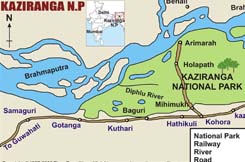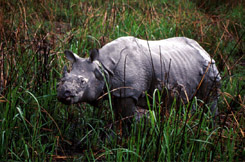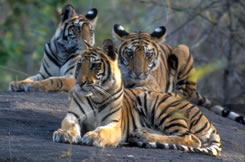Kaziranga's forests are known for their great bio-diversity, comprising mixed savannah grassland together with evergreen, moist deciduous and swamp forest. Kaziranga's sprawling valley of 430 sq. kms is one of the last strong holds of the Great Indian One-Horned Rhinoceros. It was an alarming depletion in their numbers, due to hunting and poaching that led to the conservation of this area in 1926.
Mammals : Rhinoceros unicornis (rhino) make their largest home anywhere in the world about 1000), massive wild buffalo - ferocious bovine can weight up to 915 kilograms, Indian Bison, herd of elephants or wild boar, Barasinghas (swamp and hog deer), hoolock gibbons, capped langur, Sloth Bears, leopards, tigers, Jungle Cats, Otters, Hog Badgers, Jackal.
Birds Life : is also an ornithologist's delight the grasslands are raptor country with crested serpent eagle, the Pallas fishing eagle and grey headed fishing eagle can be seen circling over the marshes. The water-bird species include swamp partridge, bar-headed goose, whistling teal, the Bengal florican, storks, herons and even pelicans. The numerous water bodies are rich Reserveoirs of food (including fish) and thousands of migratory birds, representing over 100 species, visit the park seasonally from as far as Siberia . Major migratory birds are the grey pelican, black-necked stork, lesser adjutant stork, Pallas's fish eagle, grey-headed fish eagle, about 25-30 Bengal floricans, swamp partridge, grey peacock-pheasant, great pied hornbill, green imperial pigeon, and silver-breasted broadbill.
Reptiles : rock python, monitor lizards.
Mode of Safaris: Elephant and jeep both
In addition to elephant rides, several watch towers have been set up for elevated viewing of the wildlife park. |


